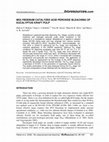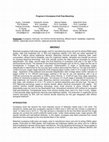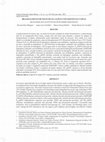Papers by Marcos Sousa Rabelo

February 2008
Chemical demand, yield, water consumption, effluent load and treatability, pulp organic chlorine ... more Chemical demand, yield, water consumption, effluent load and treatability, pulp organic chlorine compounds (OX), brightness stability, refinability, and strength are drivers for choosing bleaching technology. This work critically reviews the state-of-the-art processes for oxygen delignification, first stage, second stage, and final bleaching of eucalyptus kraft pulp in light of those drivers. Emerging technologies, such as the PMo stage and formaldehyde assisted bleaching, are discussed. Implementation of single- or double-stage oxygen delignification is determined by the pulp “true” lignin content. High pulp HexAs content and poor selectivity limits dropping kappa number under 9-10 in single or double O-stage. Mo-catalyzed acid peroxide delignification after O-stage allows further reduction of kappa number to 3-4. Efficient post-oxygen washing is the key for low cost bleaching, with a kilogram of COD/o.d. ton consuming the equivalent to 0.085% active chlorine. A/D-(EP)-D type three...

BioResources
Molybdenum catalyzed peroxide bleaching (PMo Stage) consists of pulp treatment with hydrogen pero... more Molybdenum catalyzed peroxide bleaching (PMo Stage) consists of pulp treatment with hydrogen peroxide under acidic conditions in the presence of a molybdenum catalyst. Molybdenum is applied in catalytic doses (50-200 mg/kg pulp) and may originate from various sources, including (NH4)6Mo7O24.4H2O, Na2MoO4.2H2O, siliconmolybdate, etc. This work is aimed at optimizing the PMo stage and evaluating its industrial application in the OAZDP sequence. Optimum PMo stage conditions for bleaching eucalyptus pulp were 90 ºC, pH 3.5, 2 h, 0.1 kg/adt Mo and 5 kg/adt H2O2. The PMo stage was more efficient to remove pulp hexenuronic acids than lignin. Its efficiency decreased with increasing pH in the range of 1.5-5.5, while it increased with increasing temperature and peroxide and molybdenum doses. The application of the PMo stage as replacement for the A-stage of the AZDP sequence significantly decreased chlorine dioxide demand. The PMo stage caused a decrease of 20-30% in the generation of organi...
Dissertacao (mestrado) - Universidade Federal de Santa Catarina, Centro Tecnologico. Curso de Pos... more Dissertacao (mestrado) - Universidade Federal de Santa Catarina, Centro Tecnologico. Curso de Pos-Graduacao em Engenharia Quimica
Page 1. MARCOS SOUSA RABELO TECNOLOGIAS AVANÇADAS PARA PRÉ-BRANQUEAMENTO DE POLPA KRAFT DE EUCALI... more Page 1. MARCOS SOUSA RABELO TECNOLOGIAS AVANÇADAS PARA PRÉ-BRANQUEAMENTO DE POLPA KRAFT DE EUCALIPTO Tese apresentada à Universidade Federal de Viçosa, como parte das exigências do Programa ...
Research, Society and Development, 2019
This study aimed to verify the main difficulties, access and use of digital media for students of... more This study aimed to verify the main difficulties, access and use of digital media for students of two higher education courses, being a night technologist, and a bachelor of engineering full time. For validation, a quantitative approach research was conducted through the application of a questionnaire, the results are organized and presented in graphs. We observed that students use their mobile phone mainly to access social networks, email, listen to music and take pictures, while the computer is used for formatting texts, images, spreadsheets and presentations. Another point observed is that students who study full time pointed to access to the Internet as the greatest difficulty, while at night, the main one was technical knowledge.

Bleached eucalyptus kraft pulps are largely used for manufacturing tissue and print & writing (P&... more Bleached eucalyptus kraft pulps are largely used for manufacturing tissue and print & writing (P&W) paper grades. High final brightness (92 % ISO) and brightness stability (<2% ISO) are rather significant for P&W for it affects optical brighteners demand. Bleaching chemical demand, bleaching yield, water consumption, effluent load & treatability, pulp OX, brightness stability, refinability and strength are drivers for choosing bleaching technology. This work critically reviews the state-of-the-art processes for oxygen delignification, first stage, second stage and final bleaching of eucalyptus kraft pulp in the light of the aforementioned drivers. The potential of new bleaching technologies such as the PMo stage and the use of formaldehyde in D-stages are also presented. Implementation of single or double-stage oxygen delignification is determined by the true pulp lignin content (discounted the HexA ́s). The high pulp HexA ́s content and poor oxygen stage selectivity limits dropp...

Ciência Florestal, 2011
A polpa kraft de Eucalyptus spp., em razão do elevado conteúdo de ácidos hexenurônicos, é relativ... more A polpa kraft de Eucalyptus spp., em razão do elevado conteúdo de ácidos hexenurônicos, é relativamente fácil de ser branqueada Dessa forma, estudos têm sido feitos para diminuir o número de estágios de branqueamento na planta, minimizando assim importantes custos do processo. Este estudo teve como objetivo a avaliação de sequências curtas de branqueamento ECF (Elemental Chlorine Free) e TCF (Totally Chlorine Free): PMoDP (Peróxido de hidrogênio catalisado com molibdênio, seguido por estágios de dióxido de cloro e peróxido de hidrogênio), PMoD/P (Peróxido de hidrogênio catalisado com molibdênio, dióxido de cloro e peróxido de hidrogênio, sem lavagem entre os dois últimos estágios), PMoD(PO) (Peróxido de hidrogênio catalisado com molibdênio, dióxido de cloro e peróxido de hidrogênio pressurizado), D(EPO)DP (Dióxido de cloro, extração oxidativa com oxigênio e peróxido de hidrogênio, dióxido de cloro e peróxido de hidrogênio), PMoQ(PO) (Peróxido de hidrogênio catalisado com molibdênio,...
Química Nova, 2009
Optimum conditions to run the P Mo stage for bleaching eucalyptus kraft pulp were 90 ºC, pH 3.5, ... more Optimum conditions to run the P Mo stage for bleaching eucalyptus kraft pulp were 90 ºC, pH 3.5, 2 h, 0.1 kg/t Mo and 5 kg/t H 2 O 2. The P Mo stage efficiency increased with decreasing pH (1.5-5.5) and increasing temperature (75-90 °C), time (2-4 h), and hydrogen peroxide (3-10 kg/t) and molybdenum concentration (0.1-0.4 kg/t). The implementation of the P Mo stage, as replacement for the A stage, decreased total active chlorine demand of the OAZDP sequence by 6 kg/t to reach 90% ISO, both in laboratory and mill scale. Such practice resulted in decreased bleaching chemical costs to produce fully bleached pulp of 90% ISO.










Uploads
Papers by Marcos Sousa Rabelo